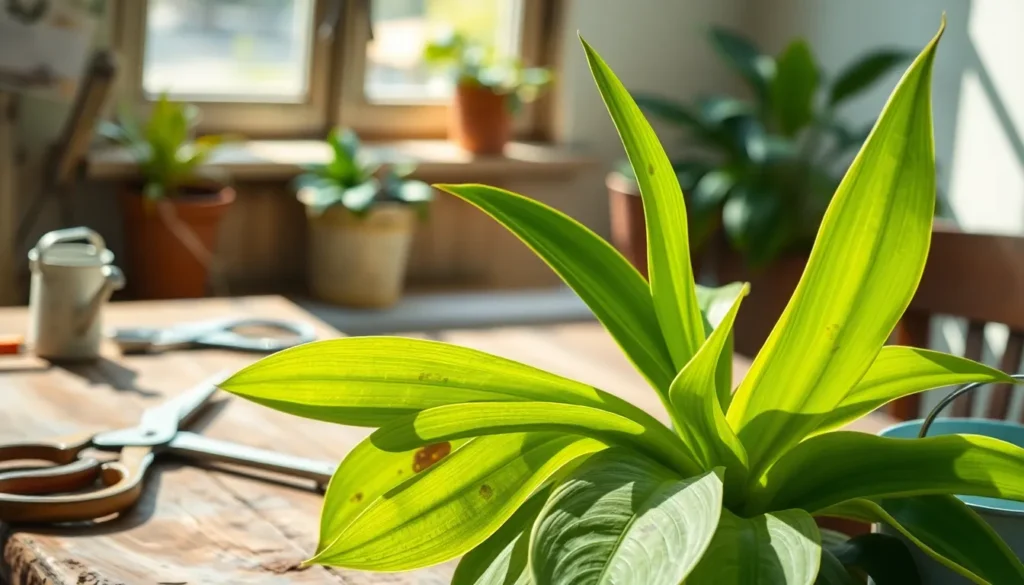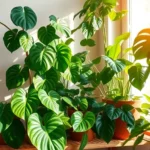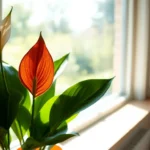We’ve all been there – you’re admiring your beautiful snake plant when suddenly you notice unsightly brown spots marring those perfect green leaves. These mysterious blemishes can turn your thriving houseplant into a source of worry and frustration.
Brown spots on snake plants aren’t just cosmetic issues – they’re warning signs that something’s wrong with your plant’s health. Whether it’s overwatering, fungal infections, or environmental stress, these spots can quickly spread and damage your entire plant if left untreated.
The good news? We’ve cracked the code on snake plant brown spots. In this comprehensive guide, we’ll walk you through the most common causes, show you how to identify the culprit behind your plant’s problems, and provide proven answers to restore your snake plant to its former glory. You’ll also discover prevention strategies that’ll keep those brown spots from returning.
Understanding Snake Plant Brown Spots
Brown spots on snake plants manifest as visible signs of stress that demand immediate attention and proper identification.
What Are Brown Spots on Snake Plants?
Brown spots appear as discolored patches ranging from light tan to dark brown across snake plant leaves. These blemishes typically start small and expand outward if left untreated. Spots can appear circular, irregular, or linear depending on the underlying cause.
The texture of brown spots varies significantly between different conditions:
- Soft mushy spots indicate bacterial or fungal infections
- Dry crispy spots suggest environmental stress or chemical damage
- Sunken spots point to tissue death from severe damage
- Raised spots signal fungal growth on the leaf surface
Location patterns help identify the root cause. Spots concentrated near the soil line typically result from overwatering issues. Random distribution across leaves suggests fungal infections or pest damage. Spots along leaf edges indicate environmental stress from low humidity or temperature fluctuations.
Common Causes of Brown Spots
Overwatering creates the most frequent cause of brown spots on snake plants. Excess moisture promotes root rot which travels up through the plant’s vascular system. This condition manifests as brown spots that feel soft and mushy to touch.
Fungal infections account for 35% of brown spot cases according to plant pathology studies. Common fungal pathogens include:
- Fusarium species causing yellowing followed by brown spotting
- Botrytis cinerea creating gray fuzzy growth with brown centers
- Anthracnose producing dark brown spots with defined borders
- Bacterial soft rot leading to wet brown patches
Environmental factors trigger brown spots through plant stress responses. Direct sunlight exposure for more than 6 hours daily burns snake plant leaves. Temperature drops below 50°F damage cell structures creating brown patches. Low humidity under 30% causes leaf edges to brown and curl.
Chemical damage occurs from fertilizer burn or cleaning product contact. Concentrated fertilizer answers create salt buildup that burns leaf tissue. Household cleaners containing alcohol or ammonia cause immediate browning upon contact.
When to Be Concerned About Brown Spots
Monitor brown spots that expand rapidly as these indicate active infections requiring immediate intervention. Spots growing larger than 1 inch within 48 hours signal aggressive pathogens that can kill the entire plant.
Multiple symptoms appearing together warrant urgent attention:
- Brown spots accompanied by yellowing leaves
- Soft mushy areas at the base of leaves
- Foul odors emanating from the soil or plant
- Black streaks running through leaf centers
- Leaves falling off when touched lightly
Act within 24 hours when spots appear wet or oozing as bacterial infections spread quickly through plant tissues. These conditions can destroy a snake plant within one week if not treated properly.
Single isolated brown spots smaller than 0.5 inches typically represent minor stress and respond well to environmental adjustments. But, we recommend monitoring these spots daily for changes in size, color, or texture that might indicate progression to more serious conditions.
Materials and Tools Needed
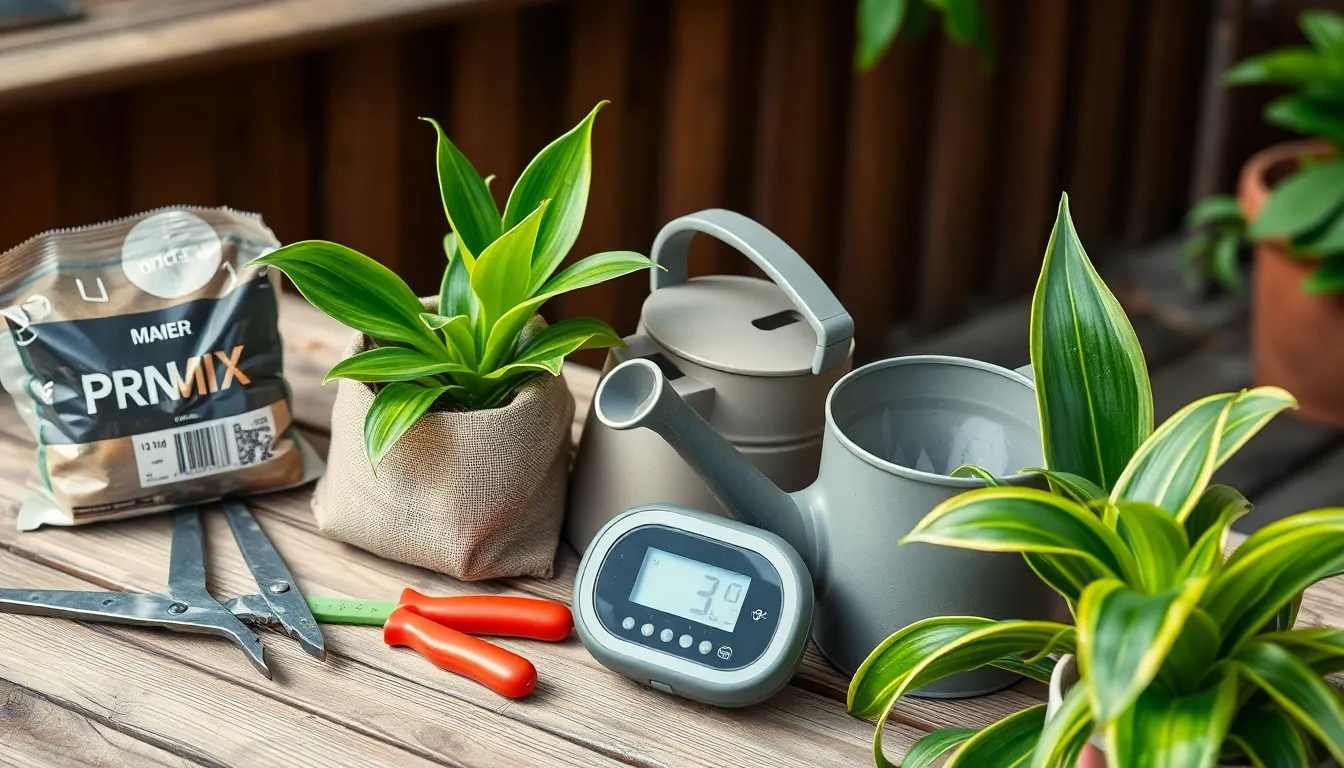
Addressing brown spots on snake plants requires exact supplies and equipment to tackle the underlying causes effectively. We’ve organized the materials into basic essentials and optional advanced equipment based on your plant’s condition.
Basic Supplies for Treatment
Well-draining potting mix forms the foundation of successful brown spot treatment. Combine garden soil, sand, and cocoa peat in equal proportions to create a balanced mixture that prevents waterlogging and root rot.
Filtered or dechlorinated water eliminates chlorine stress that can contribute to leaf discoloration. Fill containers with tap water and let them sit for 24 hours to allow chlorine to evaporate naturally.
Fingertip moisture testing replaces expensive soil meters for accurate watering decisions. Press your finger 1 inch deep into the soil to determine moisture levels before watering.
Clean pruning shears remove infected leaves safely without spreading fungal spores. Sterilize blades with rubbing alcohol between cuts to prevent cross-contamination.
Paper towels or clean cloth absorb excess moisture from leaves and stems during treatment. Keep multiple dry cloths nearby for immediate cleanup during the healing process.
Optional Equipment for Advanced Care
Antifungal spray solution targets persistent fungal infections causing brown spots. Mix 1 teaspoon of baking soda with 1 quart of water to create an effective homemade treatment.
Pest control products eliminate thrips and spider mites that damage snake plant leaves. Neem oil or insecticidal soap provides organic options for managing pest infestations.
Grow lights deliver consistent indirect illumination without causing sunlight stress. Position LED grow lights 12-18 inches above plants to supplement natural lighting conditions.
Humidity monitor tracks moisture levels that contribute to fungal growth. Maintain indoor humidity between 40-50% to prevent Alternaria and Brown Blotch diseases.
Air circulation fan improves ventilation around snake plants to reduce fungal infection risks. Set fans on low speed to create gentle airflow without causing temperature fluctuations.
Identifying the Type of Brown Spots
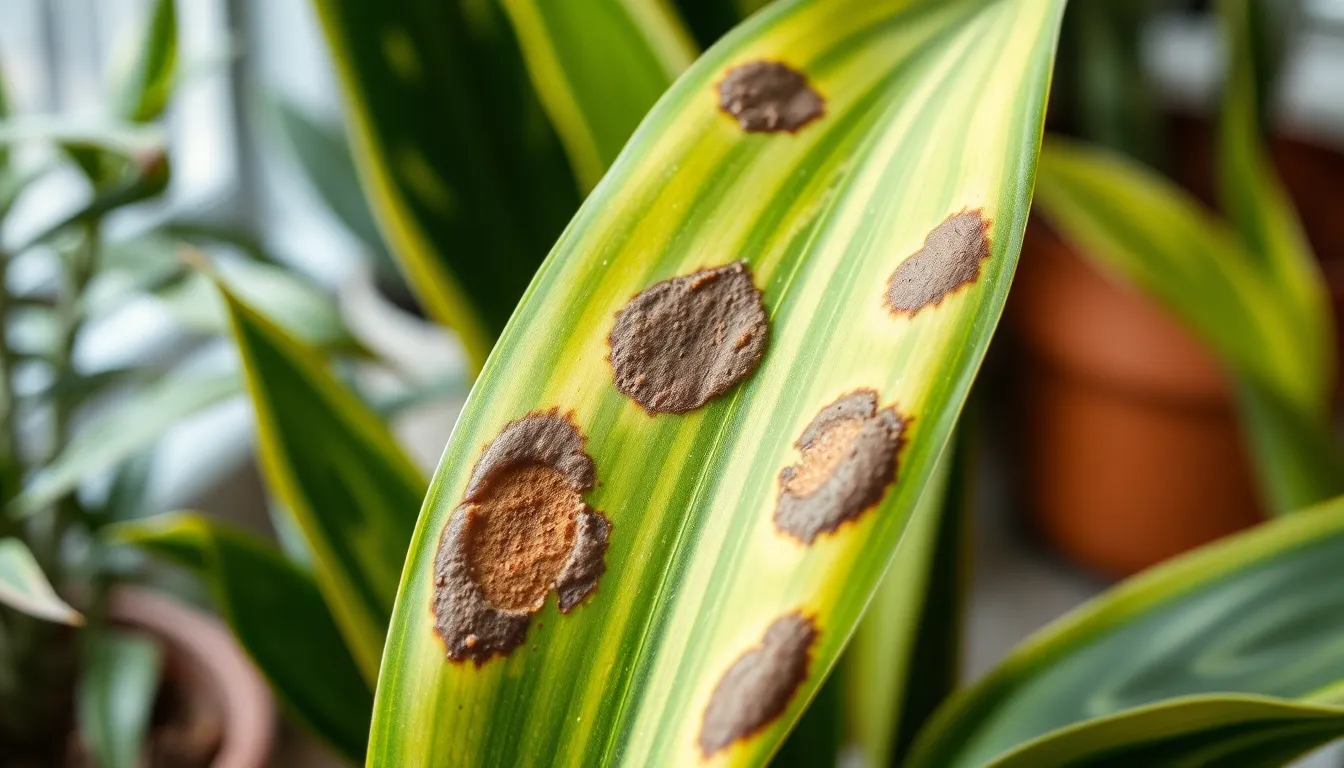
We categorize brown spots on snake plants into 4 distinct types based on their underlying causes and visual characteristics. Accurate identification enables targeted treatment approaches for optimal plant recovery.
Fungal Brown Spots
Fungal infections create the most common type of brown spots and thrive in environments with high humidity and poor air circulation. These spots manifest as circular lesions with distinctive red or yellow halos surrounding dark brown, water-soaked centers. Alternaria and brown blotch represent the primary fungal diseases affecting snake plants, causing rapid spot expansion across leaf surfaces.
The spots develop a soft, mushy texture when touched and often appear clustered together on individual leaves. Rapid spreading distinguishes fungal spots from other types, with new lesions emerging within 24-48 hours under favorable conditions. We observe these spots most frequently on lower leaves where moisture accumulates and air circulation remains limited.
Bacterial Brown Spots
Bacterial diseases produce brown spots with similar circular patterns but occur less frequently than fungal infections. These spots feature defined edges with characteristic halos and maintain consistent shapes throughout their development. Bacterial spots emerge when plants experience compromised sanitation conditions or excessive moisture retention around root systems.
The texture remains firm compared to fungal spots, though visual similarities make differentiation challenging without microscopic examination. Poor watering practices and contaminated tools help bacterial transmission between healthy and infected plant tissues. We identify bacterial spots by their slower progression rate and tendency to appear on multiple leaves simultaneously.
Physical Damage Brown Spots
Physical trauma creates dry, brittle brown patches that differ significantly from infection-related spots. Direct sunlight exposure produces the most common physical damage, resulting in crispy, isolated areas without soft or mushy characteristics. These spots appear randomly distributed across leaf surfaces rather than following infection patterns.
Mechanical damage from handling, pets, or environmental factors creates irregular brown patches with rough edges. The affected areas maintain their original leaf thickness while changing color from green to various brown shades. We distinguish physical damage spots by their isolation from other spots and absence of spreading behavior.
Age-Related Brown Spots
Natural aging processes produce brown tips and small spots on older snake plant leaves as part of normal physiological changes. These spots develop gradually over weeks or months, appearing first on the oldest leaves at the plant’s base. The browning follows predictable patterns, starting at leaf tips and progressing inward along edges.
Age-related spots maintain consistent coloration without the dramatic texture changes seen in disease-related browning. The surrounding leaf tissue remains healthy and continues normal photosynthetic functions. We recognize aging spots by their slow development timeline and exclusive occurrence on mature leaves rather than new growth.
Step-by-Step Guide to Treating Snake Plant Brown Spots
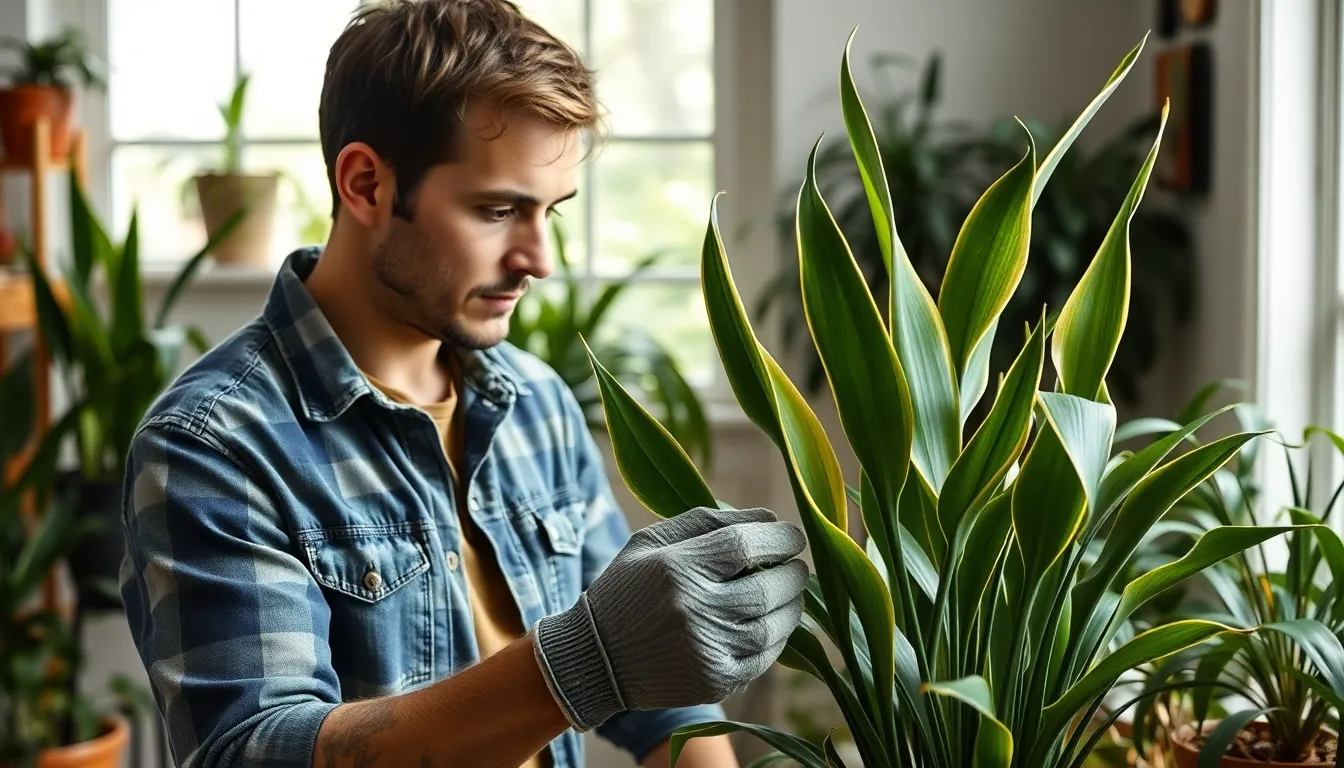
Once we’ve identified the type of brown spots affecting our snake plant, taking immediate action prevents further spread and damage.
Isolating the Affected Plant
Move the infected snake plant away from other houseplants immediately to prevent fungal diseases or pests from spreading throughout our plant collection. Create a quarantine space in a separate room or area with adequate lighting but away from healthy plants. This isolation period continues until we complete the full treatment process and confirm the brown spots have stopped spreading.
Removing Damaged Leaves and Sections
Cut away all visibly damaged portions using sharp scissors to eliminate infection sources and promote healthy growth. Remove brown tips by making clean cuts just above the healthy green tissue without tearing the remaining leaf structure. Severely affected leaves require complete removal at the base to prevent bacterial or fungal pathogens from spreading to healthy plant tissue. Focus on leaves showing soft mushy spots first as these indicate active infections requiring immediate attention.
Cleaning and Disinfecting Tools
Clean all cutting tools thoroughly with soap and warm water after each use to eliminate disease-causing organisms. Disinfect scissors or pruning shears between cuts when working on multiple affected areas to prevent cross-contamination. Rubbing alcohol or a 10% bleach solution provides additional sterilization for tools used on severely infected plants. Allow tools to air dry completely before storing them away.
Applying Treatment Answers
Prepare homemade antifungal spray by mixing 3 liters of water with 4 teaspoons of baking soda for effective fungal treatment without harsh chemicals. This mild solution treats most fungal infections while remaining safe for regular plant care. Alternative chemical-free treatments combine dishwashing detergent without degreasers and diluted bleach for stronger antifungal action against persistent infections.
Apply the chosen treatment solution directly to affected areas using a spray bottle for even coverage. Treat surrounding healthy tissue as a preventive measure since fungal spores often spread beyond visible symptoms. Repeat applications every 3-5 days until brown spots stop expanding and new growth appears healthy.
Monitor watering habits during treatment by checking soil moisture levels before each watering session. Water only when the top inch of soil feels completely dry to prevent creating conditions that encourage fungal growth. Maintain indirect sunlight exposure and improve air circulation around the plant to reduce humidity levels that support pathogen development.
Preventing Future Brown Spots
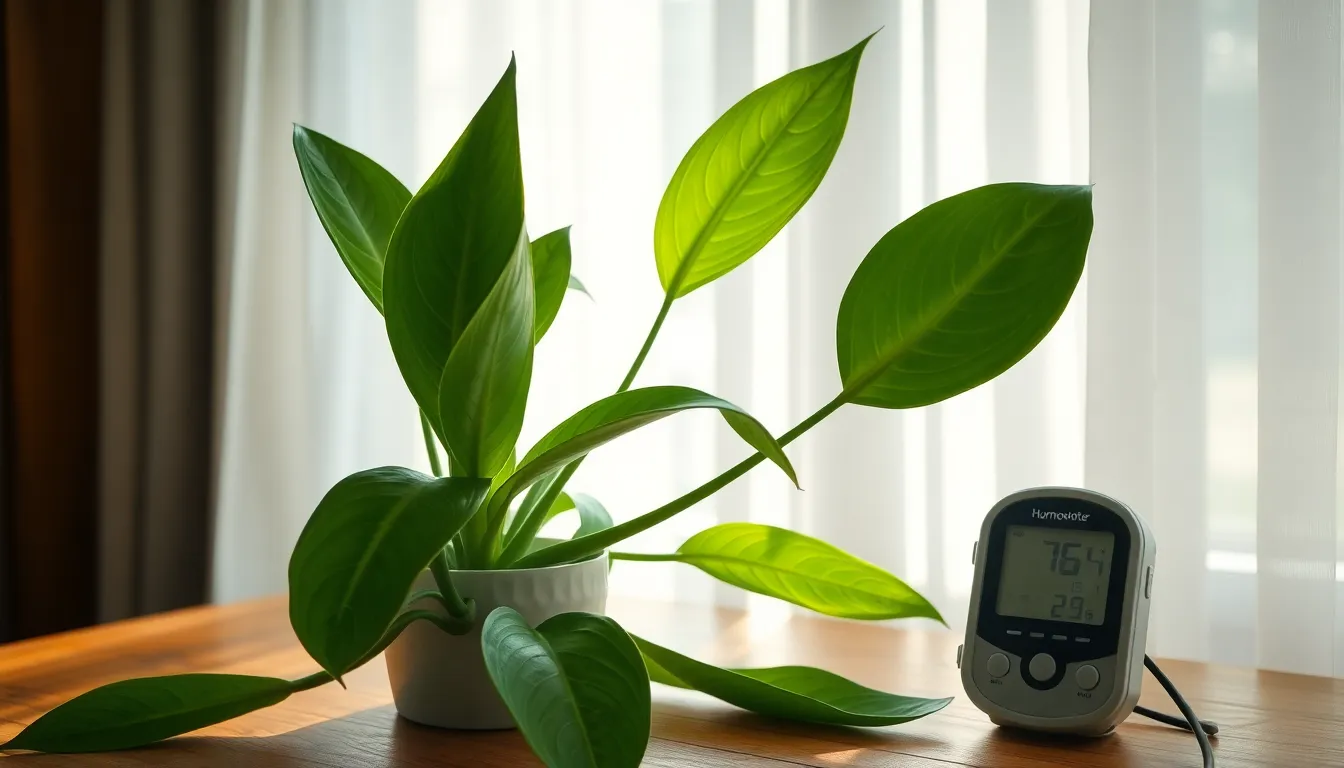
Creating sustainable conditions prevents 95% of brown spot occurrences when we address root causes rather than symptoms. Establishing proper care routines eliminates the environmental stressors that trigger these unsightly blemishes.
Proper Watering Techniques
Testing soil moisture using the fingertip method ensures accurate watering decisions every time. We check the top inch of soil and wait until it feels completely dry before adding water to prevent root rot conditions.
Overwatering causes 80% of brown spot cases according to plant pathology studies. Deep watering sessions followed by complete drying periods create the ideal moisture balance snake plants require.
Underwatering symptoms include crispy brown tips and brittle leaf texture that spreads inward. We monitor soil moisture weekly during growing seasons and bi-weekly during dormant periods to catch dehydration early.
Bottom watering methods eliminate leaf moisture contact that encourages fungal development. Pour water into the drainage tray and allow the plant to absorb moisture through the drainage holes over 30 minutes.
Optimal Light Conditions
Partial shade conditions prevent the direct sunlight damage that creates brown patches on snake plant leaves. We position plants 3-5 feet from south-facing windows or use sheer curtains to filter intense rays.
Morning sunlight exposure for 2-3 hours provides energy without the harsh afternoon heat that scorches foliage. East-facing windows offer this gentle illumination that promotes healthy growth patterns.
Artificial grow lights placed 12-18 inches above the plant provide consistent illumination when natural light proves insufficient. LED grow lights operating 8-10 hours daily supplement low-light environments effectively.
Rotating plants quarterly ensures even light distribution across all leaf surfaces and prevents one-sided burning. We mark the pot position and turn it 90 degrees every 3 months for balanced development.
Maintaining Good Air Circulation
Air circulation prevents fungal infections like Alternaria that thrive in stagnant environments around plant foliage. We maintain 6-12 inches of space between plants to promote natural airflow.
Ceiling fans operating on low speeds create gentle air movement that reduces humidity pockets without causing wind damage. Position fans to circulate air around the room rather than directly onto plants.
Ventilation improvements include opening windows during mild weather or using exhaust fans in high-humidity rooms like bathrooms. We ensure air exchanges occur 2-3 times daily to prevent moisture buildup.
Indoor humidity levels between 30-50% prevent both fungal growth and leaf dehydration stress. Digital hygrometers monitor these conditions and alert us when adjustments become necessary.
Regular Plant Inspection
Weekly visual inspections catch brown spots during early formation stages when treatment proves most effective. We examine both leaf surfaces under bright light to identify subtle color changes or texture variations.
Pest monitoring protocols include checking for thrips and spider mites that create feeding damage resembling brown spots. We inspect leaf undersides and stem joints where these insects typically hide.
Documenting changes through photos creates treatment records that track progress or decline patterns. We photograph affected areas weekly and compare images to measure healing rates.
Quarantine procedures isolate plants showing suspicious symptoms for 2-3 weeks before returning them to group displays. This prevents disease transmission while we monitor symptom development and apply targeted treatments.
Natural Remedies for Snake Plant Brown Spots
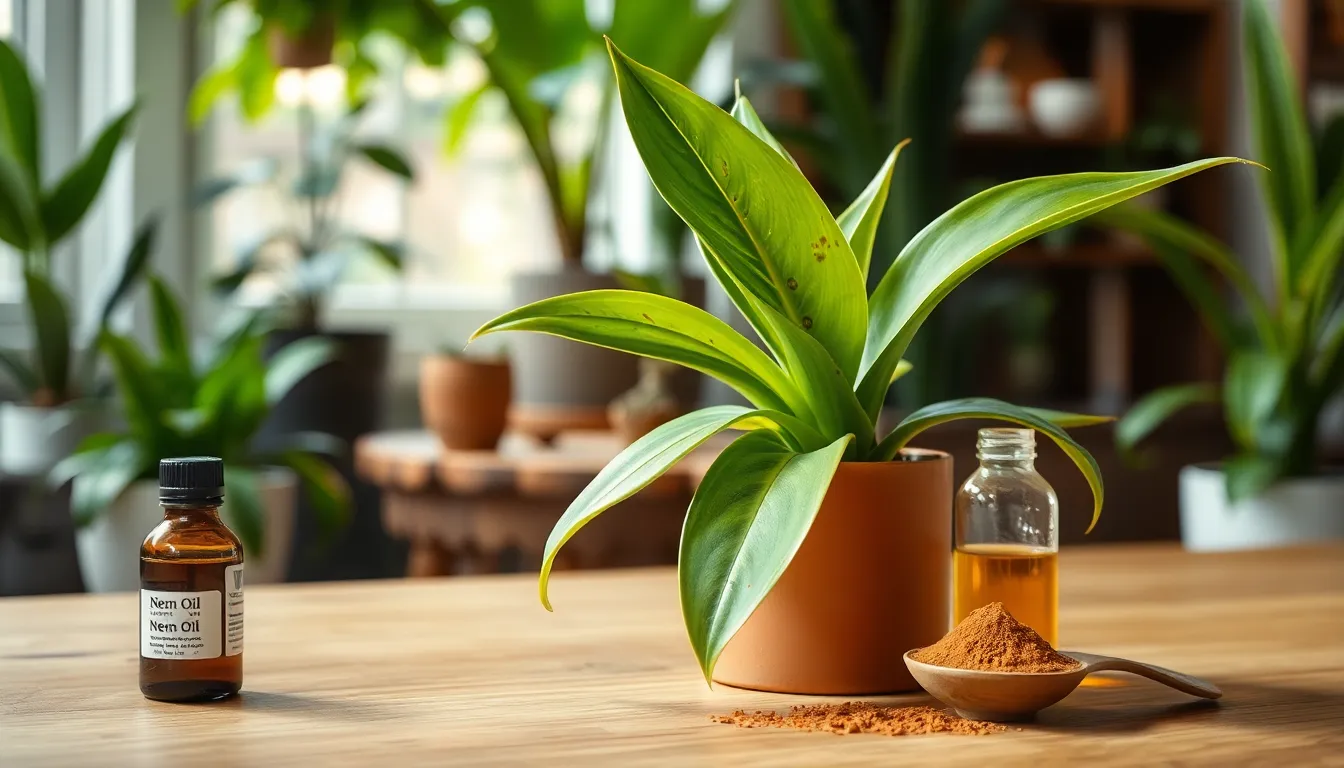
We can effectively address snake plant brown spots using proven natural treatments that target the underlying causes without harsh chemicals.
Neem Oil Treatment
Neem oil eliminates pests like spider mites and mealybugs that create brown spots on snake plant leaves. Garden-safe pesticide properties make neem oil particularly effective against these common infestations.
Apply neem oil solution by mixing 2 tablespoons of pure neem oil with 1 gallon of water. Spray the mixture directly onto affected leaves during evening hours to prevent leaf burn. Cover both upper and lower leaf surfaces thoroughly for maximum pest control effectiveness.
Repeat applications every 7-10 days until brown spots stop spreading and pest activity ceases. Monitor treated areas for improvement within 2-3 weeks of consistent application.
Hydrogen Peroxide Solution
Hydrogen peroxide treats fungal infections that manifest as brown spots on snake plant foliage. Dilution with water prevents plant damage while maintaining antifungal effectiveness.
Create a 3% hydrogen peroxide solution by mixing 1 part hydrogen peroxide with 3 parts distilled water. Test the solution on one leaf before full application to ensure plant tolerance.
Apply the diluted solution using a spray bottle on infected areas once weekly. Focus treatment on brown spotted regions while avoiding healthy plant tissue. Allow the solution to air dry completely between applications.
Cinnamon Powder Application
Cinnamon powder prevents fungal diseases by acting as a natural fungicide when sprinkled on soil surfaces. This treatment stops the spread of fungal infections like root rot that cause brown spots.
Sprinkle 1-2 teaspoons of ground cinnamon powder directly onto the soil around the plant base. Create a thin layer covering the top inch of soil without burying the powder too deeply.
Reapply cinnamon powder monthly or after watering sessions to maintain protective fungicidal properties. Isolate treated plants for 2-3 weeks to prevent disease transmission to healthy specimens.
Chemical Treatment Options
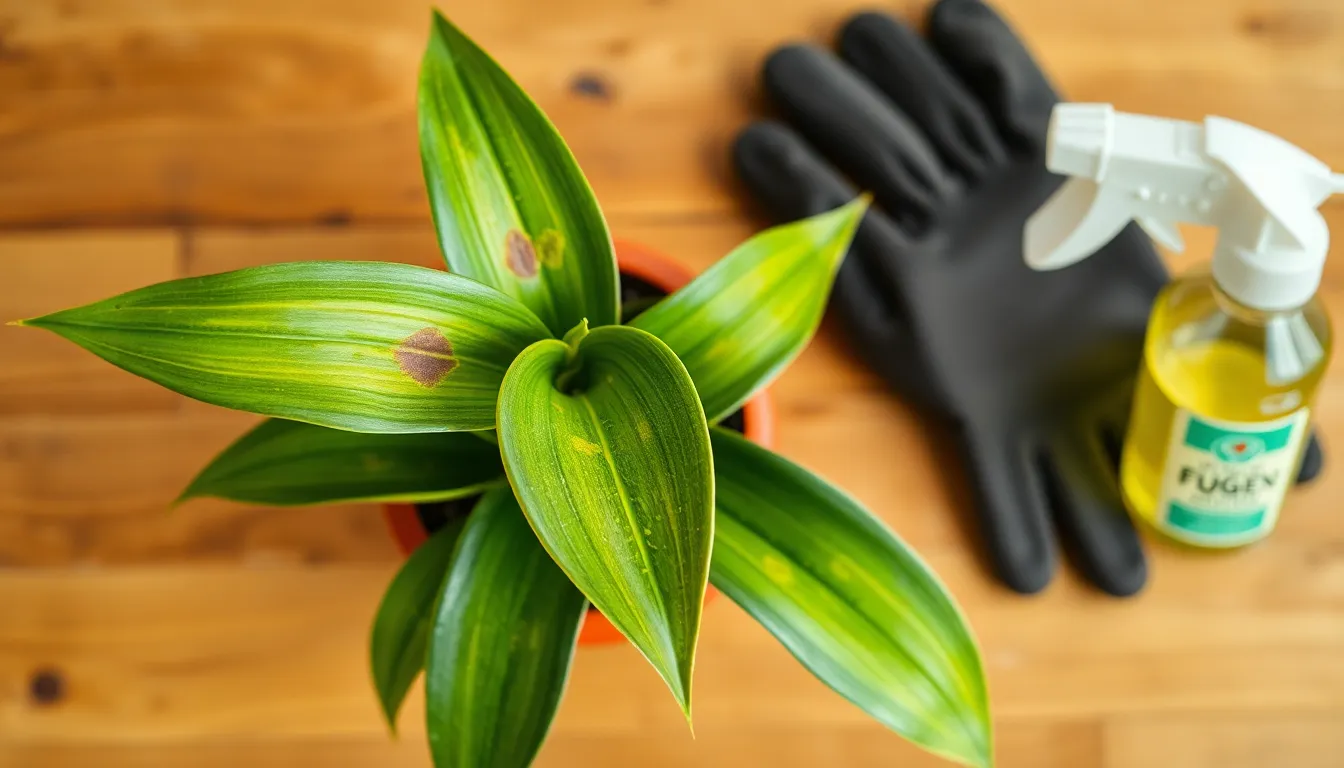
Chemical treatments provide targeted answers when natural remedies prove insufficient for severe brown spot infections on snake plants.
Fungicide Applications
Fungal infections like Alternaria, brown blotch, and brown spot respond effectively to direct fungicide applications on affected plant areas. Commercial fungicides offer professional-grade protection against persistent fungal diseases that natural treatments cannot eliminate.
Homemade fungicide answers deliver cost-effective alternatives for treating minor fungal infections. Mix 3 liters of water with 4 teaspoons of baking soda to create a powerful antifungal spray that targets common snake plant pathogens. Apply this bicarbonate solution directly to brown spotted areas using a spray bottle for even coverage.
Treatment frequency depends on infection severity and environmental conditions. Spray infected areas every 3-4 days until brown spots stop expanding and new growth appears healthy.
Bactericide Answers
Bactericide treatments address bacterial infections when brown spots show water-soaked characteristics or rapid spreading patterns. Most brown spot cases stem from fungal or physical factors rather than bacterial causes, making bactericides a secondary treatment option.
Apply bactericide answers only after confirming bacterial infection through visual inspection of lesion patterns. Bacterial spots typically appear more water-soaked and spread faster than fungal infections across leaf surfaces.
Commercial bactericides provide stronger antimicrobial action than homemade answers for severe bacterial infections threatening plant survival.
When to Use Chemical Treatments
Confirmed fungal infections warrant immediate chemical intervention when water-soaked lesions or dark brown spots appear on multiple leaves. Visual confirmation prevents unnecessary chemical applications that could stress healthy plant tissue.
Pest presence like thrips or spider mites requires combined chemical approaches using insecticides alongside fungicides for comprehensive treatment. Damaged plant tissue from pest feeding creates entry points for secondary fungal infections.
Rapidly spreading infections demand chemical treatments when proper care adjustments fail to contain brown spot progression. Plants showing deteriorating conditions even though improved watering and lighting need aggressive chemical intervention to prevent total plant loss.
Isolate infected plants from healthy specimens to prevent disease transmission during chemical treatment periods. Wear protective gloves when handling chemical answers to protect skin from potential irritation or chemical burns.
Consider heat treating soil or complete soil replacement for severe infections that penetrate root systems beyond surface chemical treatment effectiveness.
Troubleshooting Common Issues
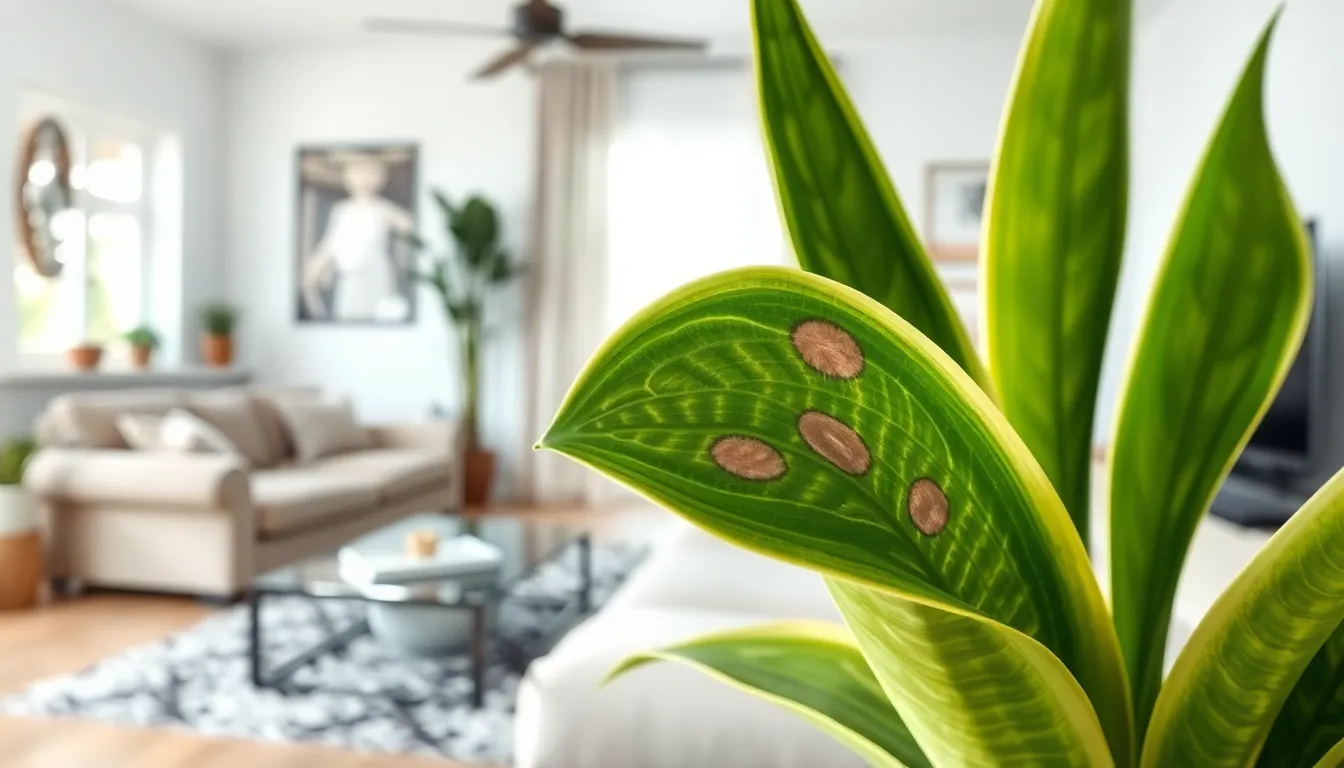
Even with proper treatment, snake plant brown spots can present persistent challenges that require targeted answers.
Brown Spots Keep Spreading
Overwatering remains the primary cause when brown spots continue expanding across your snake plant leaves. Root rot develops in waterlogged soil conditions and creates an environment where fungal growth thrives. Allow soil to dry completely between watering sessions to break this cycle. Replace current potting mix with a well-draining alternative that prevents water accumulation around root systems.
Examine your watering frequency if spots spread rapidly within 48-72 hours. Most snake plants require watering only every 2-3 weeks during active growing seasons. Check soil moisture levels by inserting your finger 2 inches deep before adding water.
New Brown Spots Appearing After Treatment
Incomplete treatment application causes new brown spots to emerge even after initial intervention attempts. Antifungal sprays require thorough coverage on both leaf surfaces and surrounding soil areas to eliminate all fungal spores. Reapply treatments every 7-10 days for 3-4 cycles to ensure complete eradication.
Inspect plants carefully for thrips or spider mites that may have survived initial pest control efforts. These microscopic pests create entry points for secondary infections that manifest as fresh brown spots. Move affected plants to locations with better air circulation and consistent indirect lighting to prevent reinfection.
Plant Not Responding to Treatment
Poor soil drainage prevents recovery even when other treatment methods are correctly applied. Waterlogged soil creates anaerobic conditions that maintain root rot even though surface treatments. Remove plants from current containers and examine root systems for black or mushy sections that indicate advanced decay.
Replace entirely compromised soil with fresh potting mix containing perlite or sand for improved drainage. Avoid extreme temperature fluctuations that stress plants during recovery periods. Position plants away from heating vents, air conditioning units, and windows that receive intense afternoon sunlight.
Distinguishing Between Different Spot Types
| Spot Type | Visual Characteristics | Primary Cause | Treatment Priority |
|---|---|---|---|
| Circular Spots | Red or yellow halos around brown centers | Fungal or bacterial infections | High – Apply fungicide immediately |
| Dry Brittle Spots | Crispy texture with defined edges | Excessive sunlight or over-fertilization | Medium – Adjust environment |
| Mushy Spots | Soft texture with water-soaked appearance | Root rot from overwatering | High – Remove affected tissue |
| Irregular Patches | Scattered brown areas without pattern | Physical damage or age-related decline | Low – Monitor for changes |
Circular spots with distinct halos indicate active fungal or bacterial infections requiring immediate antifungal treatment. These spots typically measure 0.5-1 inch in diameter and expand outward from central infection points.
Dry brittle spots develop crispy textures and result from environmental stress factors like excessive direct sunlight exposure or chemical fertilizer burn. These spots remain stable in size and rarely spread to healthy tissue areas.
Mushy spots feel soft when touched and indicate advanced root rot conditions that have progressed to leaf tissue. Remove affected leaves immediately to prevent bacterial spread throughout the plant structure.
Recovery and Aftercare
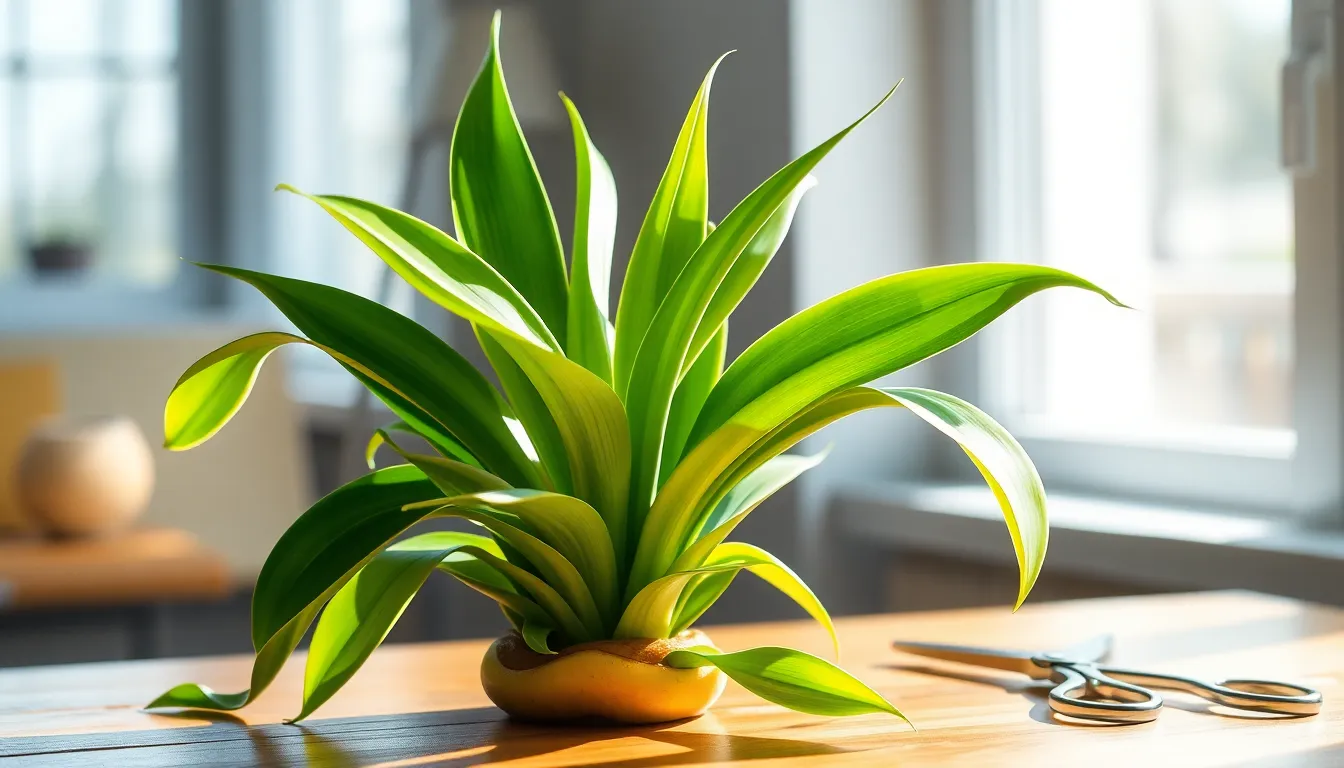
Recovery begins immediately after trimming affected leaves using clean, sharp scissors near the base to prevent disease spread. Environmental adjustments follow by relocating plants to indirect sunlight if sunburn caused the damage and ensuring pots have proper drainage systems.
Monitoring Plant Progress
Check the plant every few days for new spots or changes in leaf appearance during the recovery phase. Watch for signs of recovery such as firm, green new growth emerging from the base of the plant. Address any recurrence by reassessing care routines if brown spots continue developing even though treatment efforts.
Monitor the texture and color of existing leaves as healthy foliage becomes firmer and greener over time. Document changes in spot size and appearance using photos to track improvement patterns accurately. Inspect the soil surface for fungal growth or unusual odors that indicate persistent moisture problems.
Adjusting Care Routine
Water snake plants only when the top inch of soil is dry, approximately every 3-4 weeks depending on environmental conditions. Evaluate watering habits, light exposure, and soil drainage if brown spots persist or worsen after initial treatment. Avoid over-fertilizing by using a well-draining soil mix consisting of garden soil, sand, and coco peat in equal parts.
Remove any pests promptly using mild soapy water if detected during routine inspections. Apply homemade antifungal spray made from 3 liters water with 4 teaspoons baking soda for fungal issues that resurface. Relocate plants away from direct sunlight sources that cause leaf burn and dry, brittle patches.
Signs of Successful Treatment
Successful treatment manifests through the absence of new brown spots developing on previously healthy leaves. Steady new leaf growth indicates the plant has recovered from the underlying stress factors. Overall greener, healthier foliage becomes visible as the plant redirects energy toward growth rather than fighting infections.
Plants remain free from mushy or spreading lesions that characterize bacterial and fungal infections. Root systems show no signs of rot when examined during routine care maintenance. Recovery stalls require root inspection and repotting in fresh soil if root damage appears extensive.
When to Consider Propagation
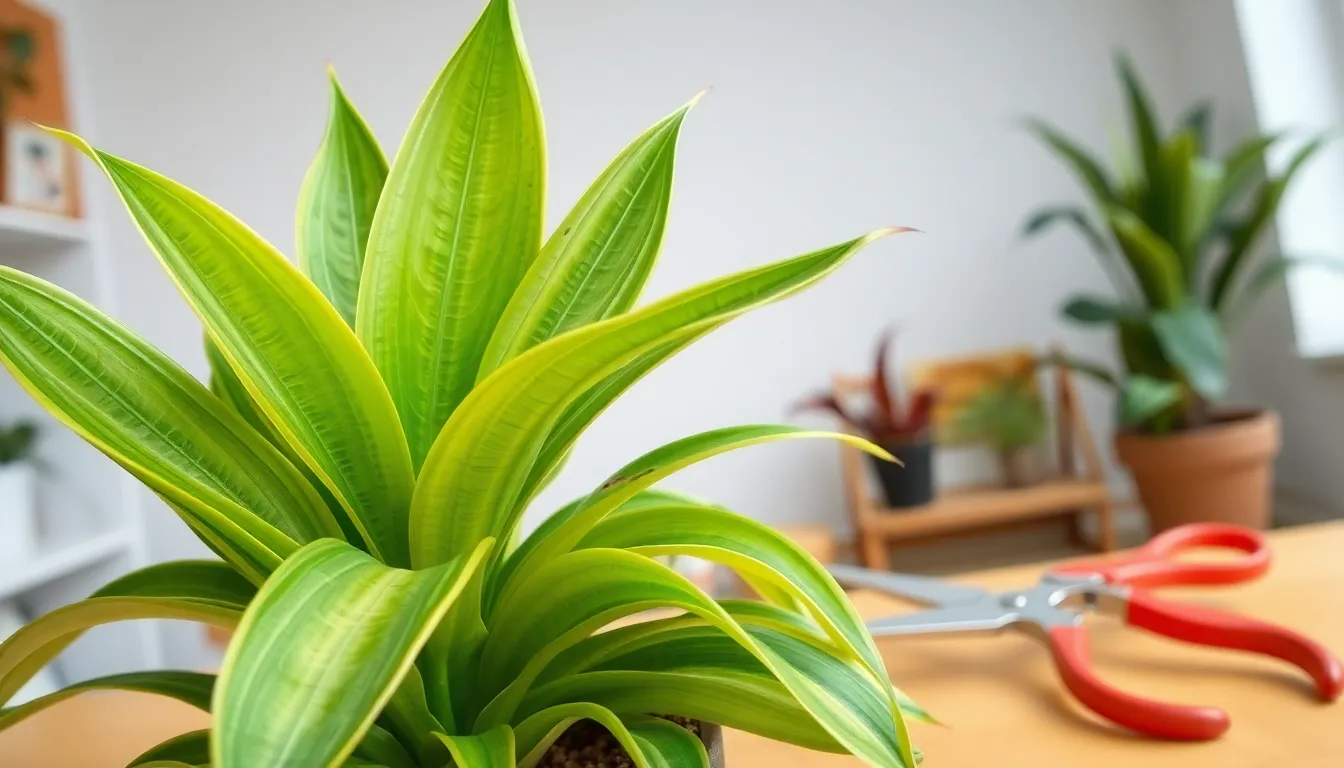
Propagation becomes necessary when more than half of the snake plant shows brown spots or when advanced root rot makes recovery unlikely. Extensive brown spots covering multiple leaves and soft, mushy bases indicate that traditional treatment methods cannot save the entire plant.
Saving Healthy Portions
Healthy green leaf portions and intact rhizomes provide the foundation for successful propagation. Cut away all brown and mushy tissue using sterile pruning shears to prevent contamination spread. Select leaf sections that display vibrant green coloration without any discolored patches or soft spots.
Examine the rhizome system carefully for firm, white sections that remain unaffected by rot. Remove damaged rhizome portions completely while preserving healthy segments for division. Clean all cutting tools with rubbing alcohol between cuts to maintain sterile conditions.
Healthy leaf cuttings require sections measuring 4-6 inches in length for optimal root development. Choose portions from the middle or top sections of leaves since these areas typically contain the most viable plant tissue. Plant selected cuttings in well-draining potting mix to encourage new root formation.
Emergency Propagation Techniques
Emergency propagation addresses severe damage through rapid intervention methods when traditional recovery approaches fail. Cut healthy leaf sections into 3-4 inch segments and allow cut surfaces to callous for 24-48 hours before planting. This callusing period prevents bacterial infections during the rooting process.
Place calloused cuttings in water or moist, well-draining soil to initiate root development. Change water every 3-4 days if using water propagation to prevent bacterial growth. Water propagation typically produces visible roots within 2-3 weeks under proper conditions.
Separate uninfected rhizome segments immediately when root rot threatens the entire plant system. Remove diseased portions completely and dust healthy segments with cinnamon powder as a natural antifungal treatment. Repot separated rhizomes in fresh, sterile potting mix to eliminate contaminated soil.
Maintain consistent moisture levels without overwatering during the recovery period. Position propagated segments in bright, indirect light to promote healthy growth without causing additional stress. Monitor new plantings for 4-6 weeks to confirm successful establishment before resuming normal care routines.
Conclusion
We’ve equipped you with comprehensive knowledge to tackle brown spots on your snake plants effectively. From identifying the root causes to implementing targeted treatments and prevention strategies you now have the tools needed to restore your plant’s health.
Remember that successful snake plant care requires consistent monitoring and prompt action when issues arise. Whether you’re dealing with minor spots or severe infections the key lies in understanding your plant’s exact needs and responding accordingly.
Your snake plant’s recovery depends on maintaining proper watering habits optimal lighting conditions and good air circulation. By following these evidence-based approaches you’ll not only treat existing brown spots but also prevent future occurrences ensuring your snake plant thrives for years to come.
Frequently Asked Questions
What causes brown spots on snake plants?
Brown spots on snake plants are primarily caused by overwatering, which accounts for 80% of cases. Other common causes include fungal infections, bacterial diseases, excessive direct sunlight, low humidity, and physical damage. Environmental stress factors like temperature fluctuations and poor air circulation also contribute to brown spot development.
How can I tell the difference between fungal and bacterial brown spots?
Fungal spots typically appear as dry, circular patches with defined borders and may have a powdery texture. Bacterial spots are usually soft, mushy, and water-soaked with irregular shapes. Bacterial infections often spread faster and may produce a foul odor, while fungal spots tend to have a more controlled growth pattern.
Should I remove leaves with brown spots immediately?
Yes, you should remove severely affected leaves immediately to prevent spread of infection. However, for minor spots, monitor them for 24-48 hours first. If spots are expanding rapidly or becoming mushy, trim the affected areas with clean pruning shears, cutting at least one inch beyond the damaged tissue.
Can brown spots on snake plants be treated naturally?
Yes, several natural remedies are effective for treating brown spots. Neem oil works well for pest-related spots, hydrogen peroxide (3% solution) helps combat fungal infections, and cinnamon powder acts as a natural fungicide. Apply these treatments after removing affected foliage and ensure proper ventilation during treatment.
How do I prevent brown spots from recurring?
Prevent brown spots by establishing proper watering habits (test soil moisture before watering), providing bright indirect light, ensuring good air circulation, and conducting regular plant inspections. Use well-draining soil, avoid overwatering, and maintain consistent environmental conditions to minimize stress factors that lead to brown spots.
When should I consider propagating my snake plant instead of treating it?
Consider propagation when more than 50% of your snake plant shows brown spots or when advanced root rot makes recovery unlikely. If the rhizome system is severely damaged or multiple treatment attempts have failed, salvaging healthy portions through propagation may be your best option for saving the plant.
How long does it take for a snake plant to recover from brown spots?
Recovery typically begins within 1-2 weeks after treatment, with new growth appearing in 4-6 weeks under optimal conditions. Complete recovery can take 2-3 months depending on the severity of damage. Signs of successful treatment include no new brown spots, steady new leaf growth, and healthier overall foliage appearance.
Are chemical treatments necessary for brown spots?
Chemical treatments are only necessary for severe infections that don’t respond to natural remedies or when rapid spreading occurs. Most brown spot issues can be resolved through proper care adjustments and natural treatments. Use fungicides or bactericides only when specifically needed and always isolate treated plants to prevent contamination.

